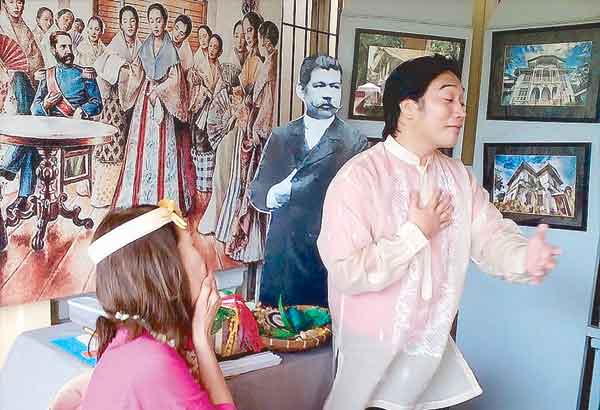Malolos in musical docu and our minds
MANILA, Philippines - With the phenomenal success of the film Heneral Luna, our patriotic veins are throbbing, and we deemed it timely to retrace our history to the cradle of the First Philippine Republic, Malolos. With the 2014 musical video documentary, Ang Kababaihan ng Malolos (produced and written by Nicanor Tiongson and directed by Sari and Kiri Dalena, starring Hazel Faith dela Cruz, Karl Medina, Bong Enriquez and Carlos Celdran) in our minds, my friend Rey Candido (teacher of Filipino at the International School) and I went on a walking and rolling tour of this capital city of Bulacan. Sponsored by Barangay San Lorenzo, Makati’s Kagawad Marlene Po, this was a Heritage and Culinary Tour that gave us time to probe our identity and remember the gifts of womanhood, motherhood and nationhood that helped shape it through history.
First, there is the innate strength of the Filipina. In the documentary, Basilia Tantoco narrates the events from 1888 to 1906 when the Women of Malolos worked for the liberation of the country and of Filipino women. In 1888, these kindred ladies requested Governor General Weyler for permission to open a night school where they could learn Spanish. The Spanish friars saw this as a political move, and vehemently objected, but the feisty women opened their school in 1889. At the behest of another Bulakeño, the termagant Marcelo H. del Pilar, Jose Rizal wrote the now immortal Letter to the Young Women of Malolos. The school lasted for only four months because the threatened clergy closed it down, but this did not deter the women of Malolos from their civic duties. From 1896 to 1897, many of the women provided food, arms and clothes for the Katipuneros of Bulacan.
During the Philippines-American war in February 1899, eight of them served the first Red Cross in Malolos. In 1906, 10 joined and recruited members for the local chapter of the Asociacion Feminista Filipina (AFF), the first women’s organization in the country organized by Rizal’s sisters. The film ends with the firm resolve of Basilia’s barcada to continue the struggle for the complete liberation of Filipino women of all classes. This project was funded by Amb. Bienvenido Tantoco in celebration of the 125th anniversary of Rizal’s letter, which the Women of Malolos Foundation, Inc. (WOMFI) — through its Basilia Committee headed by media stalwart Cheche Lazaro (a forebear of one of the 20 Kababaihan ng Malolos) — spearheaded.

Putungan at the Santos-Uitangcoy house with the painting of the Kababaihan ng Malolos in the backdrop
Second, there is the critical role of mothers in teaching their children love for the three Cs: Creed or faith, Country and Community. Del Pilar’s own reactions to the cause of the Women of Malolos were recorded in a personal letter that he sent to his niece, Josefa Gatmaytan, on March 13, 1889. Addressing not only his niece, but all the women of his province, he extolled the women’s proposal as an example for the women of his native Bulacan. Then, like Rizal, he noted the influence of women over their children, and often on the rest of their family as well. Del Pilar knew that it was important to educate women, for cultivating intelligence was necessary to achieve true virtue.
In the ancestral house of one of these women, Alberta Santos Uitangcoy, we could see the strong hand that rocked the cradle: Lighting candles in the elaborate altar, arranging scores of family photos and crocheting yards of thread into works of domestic art while advancing the cause of their night school. It is only fitting that this well-preserved mansion is the venue of the Putungan or Coronacion performed by local makata Jeremy Lord Dancil, and the demonstration of Borlas de Pastillas (paper wrapper for sweets) and Puni weaving (leaf-folding) led by local culinary and weaving artist, Nicanora Teresa (Rheeza) Santiago-Hernandez, as a paean for the noble calling that is motherhood.
Third, the primacy of preserving our material culture as a tool for national pride and renewal. With another election looming in the horizon, accusations of corruption and ineptitude are flying thick and fast all over, with our integrity and identity as a nation its collateral damage. Despite the glorious revolutions (bloody and bloodless) we have fought, why are we perpetually inchoate as a people? Because we tend to forget we are descendants of an honorable tribe, who valued pride and patrimony over asinine power and instant prosperity.
It was former FEU president, Lydia Balatbat-Echauz, who told me of her clan’s efforts to restore and refurbish their ancestral home in Malolos, because it was their way of showing gratitude for their roots and passing on to the next generation their good name and family history. Thus, when we passed the Cojuangco ancestral house along the Paseo del Congreso before the Casa Real National Shrine, I understood why P-Noy was a reluctant president: He did not want to add a page of shame to the fabled history of his mother’s clan.
- Latest
- Trending





























